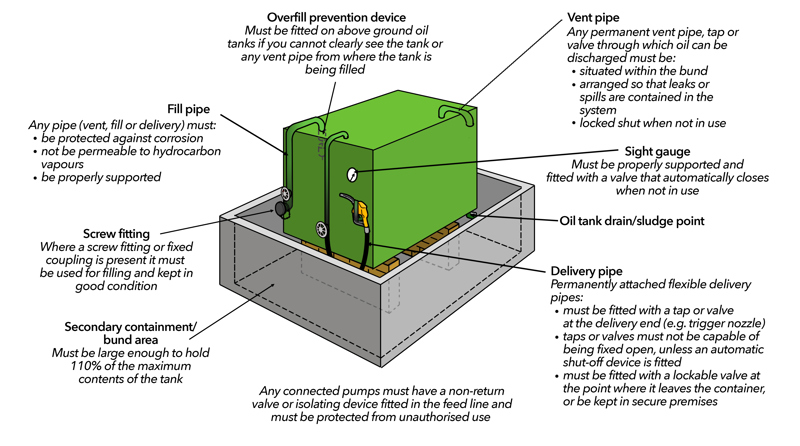Requirements for your oil or fuel storage container
To store oil safely you must comply with the requirements of the Oil Storage Regulations on primary containers. These are the main containers oil is stored in and include:
- tanks
- intermediate bulk containers (IBCs) used for transport and storage
- oil drums
- mobile bowsers - an oil container that can't move under its own power, but can be moved between locations.
In Scotland the regulations apply to portable containers, e.g. 5, 10 or 20 litre oil cans.
What you must do
Check your oil containers
You must use a strong container that won't leak or burst in ordinary use. In Scotland this is the only requirement for portable oil containers with a capacity of less than 200 litres. If they are properly maintained, containers should last at least 20 years.
Proprietary tank systems are made with integral secondary storage containment for the primary container. You should consult the manufacturer of these systems for information on their appropriate use and whether they comply with oil storage legislation.
Oil storage containers must be stored within a suitable secondary containment system, for example a bund or drip tray.
For more information, see the page in this guideline: Secondary containment systems for oil storage containers.
If your container has any fittings and pipework, for example sight gauges, valves, fill or draw-off pipes or vent pipes, you must ensure they are located and operated correctly.
For more information, see the page in this guideline: Oil container pipework and fittings requirements.
Oil storage requirements overview

Good practice
Even if the Regulations for Oil Storage do not apply, you should still store your oil responsibly and use appropriate containers which meet the regulations.
GPP 2 Above ground oil storage tanks
Make sure your storage tank has been type tested to a recognised standard and manufactured to an ISO 9001-compliant quality assurance scheme, for example:
- polyethylene tanks should comply with OFS T100
- steel tanks should comply with either BS 799-5 or OFS T200 and be corrosion-resistant.
Make sure your container is marked with the product type and maximum capacity. You should also attach a notice with information on safe delivery and emergency procedures.
This is available from the Northern Ireland Environment Agency (NIEA) and the Scottish Environment Protection Agency (SEPA).
Contact your environmental regulator
Make sure only competent qualified technicians install or decommission your oil storage tank. For more information, see the page in this guideline: Maintaining your oil storage equipment
Ensure tanks are fully drained of oil and water before they are taken out of use. This liquid is a hazardous/special waste and must be disposed of legally. Contact the NIEA or SEPA if you find evidence that the ground underneath a tank has been contaminated.
Tanks and equipment contaminated with oil are classed as hazardous/special waste.
Further information
NIEA and SEPA Water Pollution Hotline 0800 80 70 60
- Oil Care Campaign
- DAERA: Oil storage guidance for Northern Ireland
- SEPA: Oil storage guidance for Scotland
- GPP 2 Above ground oil storage tanks
- GPP 21: Pollution incident response planning
- GPP 26 Safe storage - drums and intermediate bulk containers
- GPP 27 Installation, decommissioning and removal of underground storage tanks
